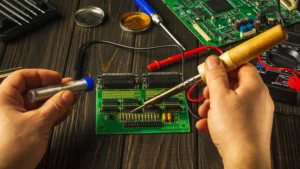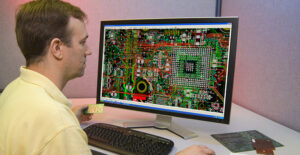PCB is the basic electronic component of all electronic circuit design, and PCB board design is a must for creators. PCB is not only a combination of scattered components, but also ensures the regularity of circuit design, which is a good way to avoid the confusion and errors caused by manual wiring and wiring. Guangzhou Club Technology PCB designers recommend this technical article on the power supply design of the PCB circuit board design of the five key points for a detailed introduction. I hope it will be helpful to you.
1. To have a reasonable direction
For example, input/output, AC/DC, strong/weak signal, high frequency/low frequency, high voltage/low voltage, etc. They should be routed in a linear fashion (or separated) and must not intermingle. The purpose is to prevent mutual interference. The best direction is in a straight line, but generally not easy to achieve, the most unfavorable direction is the ring, fortunately, can be set up to improve the isolation belt. For DC, small signal, low voltage PCB design requirements can be lower. So “reasonable” is relative.
2. Choose a good pickup point: pickup points are often the most important
There is no telling how much engineering has been done on the small grounding point, which shows its importance. In general, a common ground is required, e.g., multiple ground lines of the forward amplifier should be converged and then connected to the trunk ground, etc. In reality, due to various restrictions is difficult to do completely, but should try to follow. This issue is quite flexible in practice, everyone has their own set of solutions, and it is easy to understand if you can explain it for a specific board.
3. Proper placement of power supply filtering/decoupling capacitors
There are usually only a number of power supply filter/decoupling capacitors drawn in the schematic, but it is not indicated where they should each be connected. These capacitors are actually for switching devices (gates) or other components that need to be filtered/decoupled, and they should be placed as close to these components as possible, too far away to be useful. Interestingly, when the power supply filtering/decoupling capacitors are well placed, the grounding point issue becomes less obvious.
4. Line wire diameter has requirements for buried holes through holes of appropriate size
Conditions to do a wide line never do fine; high voltage and high frequency lines should be garden-slip, there shall be no sharp chamfer, the corner shall not be used right angle. The ground line should be as wide as possible, preferably using a large area of laid copper, which has considerable improvement on the grounding point problem. Solder pad or over the line hole size is too small, or pad size and drilling size with improper. The former is not good for manual drilling, the latter is not good for CNC drilling. Easy to drill the pad into the “c” shape, heavy drilling off the pad. The wire is too thin, and a large area of the un-wired area and not set copper, easy to cause uneven corrosion. That is, when the unwired area after corrosion, the fine wire is likely to corrode over the head, or seem to break non-break, or completely broken. Therefore, the role of copper laying is not only to increase the area of the ground and anti-interference.
5. Number of overholes solder joints and line density
Some problems are not easily detected in the early stages of circuit fabrication; they tend to emerge later, such as too many over-wire holes, and the slightest carelessness in the copper sinking process can lay hidden dangers. Therefore, the design should minimize the over-wire holes. The density of lines in parallel in the same direction is too large, and it is easy to join together when soldering. Therefore, the line density should be determined depending on the level of the soldering process. The distance of welding joints is too small for manual welding, and the welding quality can only be solved by reducing the work efficiency. Otherwise, it will leave hidden problems. Therefore, the minimum distance of the weld joint should be determined by considering the quality and work efficiency of the welders.
If you fully understand and understand the PCB design considerations above, you will be able to greatly improve your design efficiency and product quality. Correcting errors in production will save a significant amount of time and cost, as well as time and material investment in rework.
















